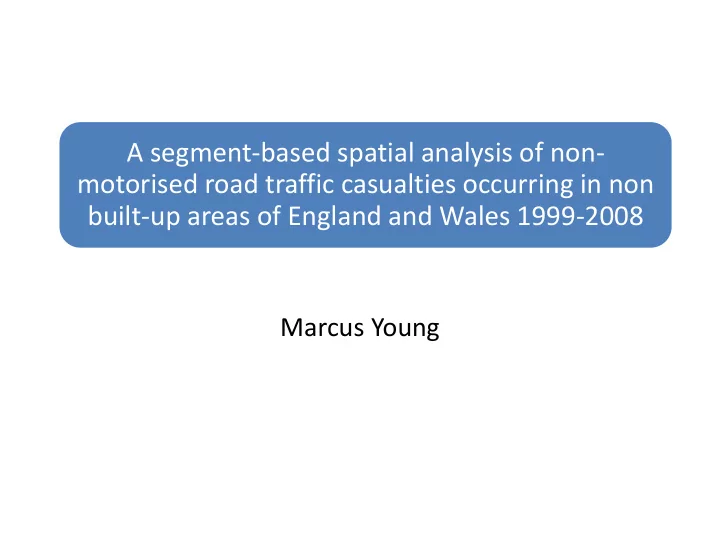

A segment-based spatial analysis of non- motorised road traffic casualties occurring in non built-up areas of England and Wales 1999-2008 Marcus Young
Background and Rationale Pedestrian casualties Pedestrian casualties Fatal, On built-up roads on non built-up roads 429, Fatal, 1.6% 122, Serious, 12.2% 5738, 20.9% Slight, Serious, 575, Slight, 307, 57.3% 21227, 30.6% 77.5% Pedestrian fatalities Cyclist fatalities non built- non up, 122, built- 22.1% Built- > 40mph = non built-up up, 57, up, 58, Built- 49.6% 50.4% <= 40mph = built-up up, 429, 77.9%
Research Aims Create a segment-based dataset for the road network in England & Wales. Assign each NMT casualty that occurred outside a built-up area to a segment and generate counts. Assign a range of relevant explanatory variables to each segment. Develop a series of negative binomial regression models. Identify key findings that can inform road safety strategy for non built-up NMT casualty reduction.
Segment Dataset OS Meridian 2 vector dataset. ONS urban area and settlement boundary polygon layer – to erase roads in built-up areas. Target a nominal fixed segment length of 250m. 742,355 segments to use in regression models
Casualty Data STATS19 – form used by the police in GB to record every personal injury RTA on a public road. Data quality issues – accident NGR. Each casualty snapped to a road polyline. Casualty counts for each segment generated (total, by casualty type, by severity). 2.8 million total casualties 499,006 NMT 37,471 NMT non built-up
Explanatory Variables Road NMT user Demographic Spatial Factors Characteristics interactions characteristics • A-class • National Trail • Local • Distance from present Population built-up area • B-class • Sustrans • Minor road route present (reference) • Dangerous • Sinuosity crossing • Number of present intersections • Steep • Traffic flow
Statistical Analysis OLS regression unsuitable – can predict negatives values/assumptions violated. NB model common in road accident analysis literature and fits the data better than Poisson. Disaggregated approach with different segment casualty counts used as the dependent variable in a series of models. Total casualties Total serious Total casualties Total fatalities (A roads) injuries Total slight Pedestrian Horse rider Cyclist casualties injuries casualties casualties Spatial Autocorrelation - Global Moran’s I indicated clustering present. Separate model for East Anglian region to introduce spatial lag of the dependent variable.
Key Findings Coefficient exponentiated and expressed as an Incidence Rate Ratio Sinuosity Intersections Road Class • A-class and B-class • Strong negative • Positive roads show strong association in association in all positive fatalities, horse models. association across rider and A-class • Incidence rate for most models. models. total casualties • Incidence rate for • For a one unit increases by a fatal casualties 12x increase in factor of 1.8 (81%) greater on A-roads sinuosity, casualty for each additional than minor roads. rate decreases by intersection. 99.9% for fatal casualties and 47.6% for A-class road.
Key Findings NMT road user Distance from Impact of spatial interactions built-up area autocorrelation • Presence of a • Negative • Spatially lagged National Trail association. variable significant. doubles the • For a one standard • Sinuosity changes pedestrian casualty deviation increase from significant at rate. in mean distance 90% confidence • A national or (2.2km) the level to non regional cycle incidence rate for significant. route increases total casualties • Other variables cyclist casualty rate reduces by a factor that are significant by a factor of 1.31. of -0.325 (-67.5%). remain so with coefficients slightly reduced.
Recommendations Focus on A-class and B-class roads to have maximum impact on reducing NMT casualties. Effect of sinuosity in reducing casualties on A-class roads suggests speed reduction measures would be effective. Stepped reductions in posted speed limits at the edge of settlements. Protective speed limits on stretches between nearby built-up areas. Programme to establish alternative routes for on-road sections of flagship National Trails.
Recommend
More recommend